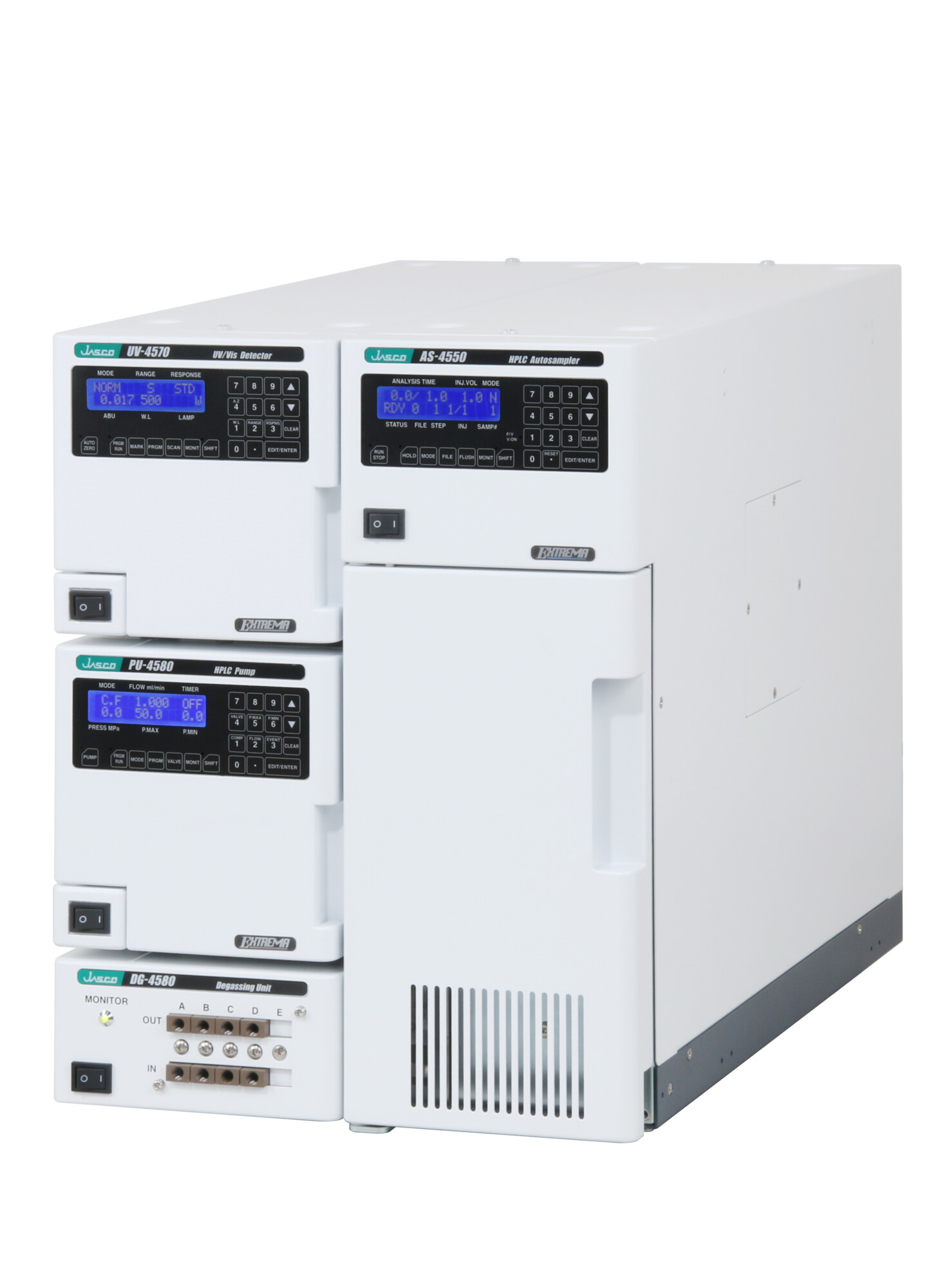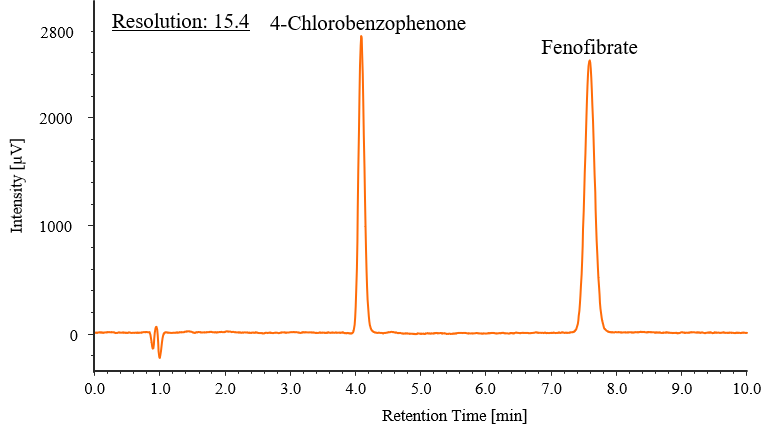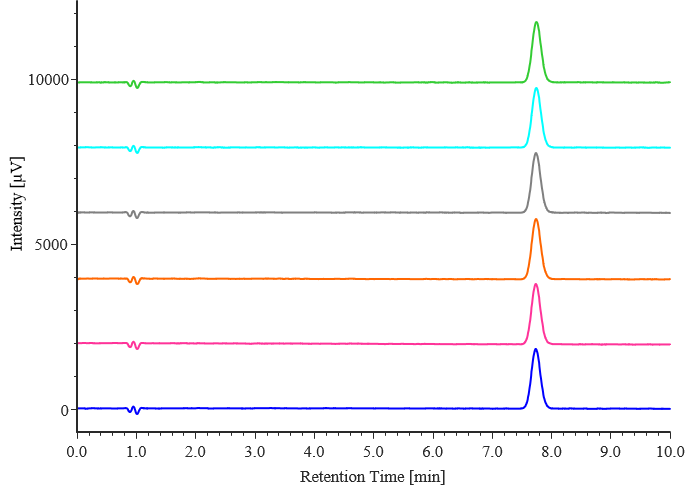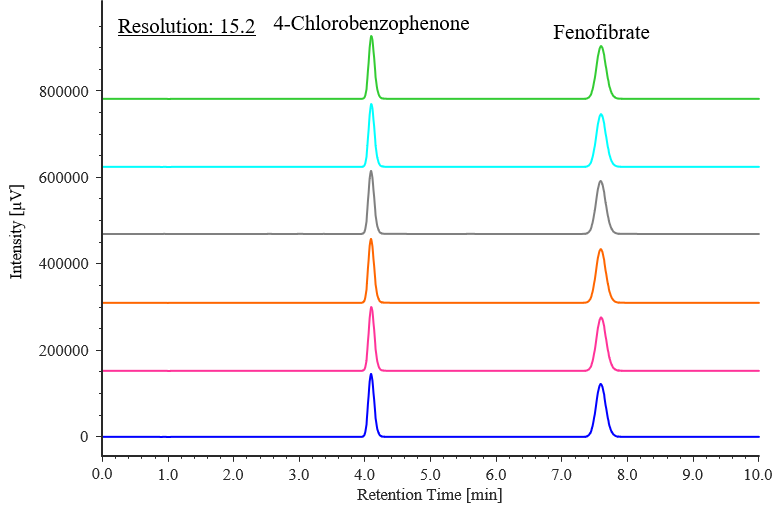Introduction
Fenofibrate is a drug newly listed in the 18th edition of the Japanese Pharmacopoeia (JP) and is used in the treatment of dyslipidemia (hyperlipidemia), which causes atherosclerosis and myocardial infarction. This drug reduces LDL cholesterol (bad cholesterol) levels and increases HDL cholesterol (good cholesterol) levels by promoting the breakdown of triglycerides and inhibiting the synthesis of cholesterol.
In this report, we present the results of a system suitability evaluation for purity tests and assays of fenofibrate in accordance with the Japanese Pharmacopoeia, 18th Edition.

LC-4500 series HPLC system
Experimental
Instruments
Pump: PU-4580
Degassing unit: DG-4580
Autosampler: AS-4550
Column oven: CO-4060
Detector: UV-4570
Conditions
Column: Unifinepak C18 (4.6 mmI.D. x 150 mmL, 5 µm)
Eluent : Acetonitrile/20 mM sodium dihydrogen phosphate (adjusted to pH 3.0 with phosphoric acid) (70/30)
Flow rate: 1.4 mL/min (adjusted so that the retention time of fenofibrate is approximately 8 minutes)
Column temp.: 40 ºC
Wavelength: 286 nm
Injection volume: 20 µL
Standard: Fenofibrate (The dissolving and diluting solvent is a mixture of acetonitrile and water (7:3).)
Internal standard: 4-Chlorobenzophenone (The dissolving and diluting solvent is a mixture of acetonitrile and water (7:3).)
Structure

Fenofibrate
Keywords
Japanese Pharmacopoeia, fenofibrate, UV detector
Results
An overview of the system suitability for purity tests and assays of fenofibrate is shown in Table 1.
Table 1 Overview of system suitability for purity tests and assays of fenofibrate
| Test | Criteria | |
| Purity | Detectability | When the test is performed under the above operating conditions on 20 µL of a standard-purity solution (0.6 mg/L) diluted to 0.12 mg/L, the area of the peak associated with fenofibrate is 15–25 % of that for the standard solution. |
| System performance | When 0.10 g of 4-chlorobenzophenone and fenofibrate are each diluted to 0.8 mg/L, and the test is performed on 20 µL of this solution under the above operating conditions, 4-chlorobenzophenone and fenofibrate are eluted in that order and the resolution for the peaks is ≥10. | |
| System reproducibility | When the test is repeated 6 times with 20 µL of the standard-purity solution under the above operating conditions, the relative standard deviation of the fenofibrate peak area is ≤5.0 %. | |
| Assay | System performance | When the test is performed on 20 µL of the fenofibrate standard-assay solution containing the internal standard, 4-chlirobenzophenone (44 mg/L and 40 mg/L, respectively) under the above operating conditions, 4-chlorobenzophenone and fenofibrate are eluted in that order and the resolution for the peaks is ≥10. |
| System reproducibility | When the test is repeated 6 times with 20 µL of the standard-assay solution under the above operating conditions, the relative standard deviation of the ratio of the fenofibrate to 4-chlorobenzophenone peak areas is ≤1.0 %. | |
(1) Purity
Figure 1 shows the results of the detectability test. The ratio of the fenofibrate peak area for the diluted solution (0.12 mg/L) to that for the standard solution (0.6 mg/L) was 20.1 %, which met the criterion of 15–25 %.

Fig.1 Chromatogram of fenofibrate for the detectability test (0.6 mg/L, 0.12 mg/L)
Figure 2 shows the results of the system performance test. 4-chlorobenzophenone and fenofibrate eluted in that order, and the resolution for the peaks was 15.4, which met the criterion of ≥10.

Fig. 2 Chromatogram of 4-chlorobenzophenone and fenofibrate for system performance (0.8 mg/L each)
Figure 3 shows chromatograms of fenofibrate standard solutions, and Table 2 shows the results for peak area reproducibility based on the measured system reproducibility. The relative standard deviation of the peak area was 0.19 %, which met the criterion of ≤5.0 %.

Fig. 3 Chromatograms of fenofibrate standard solutions (0.6 mg/L, n = 6)
Table 2 Fenofibrate peak area reproducibility (n = 6)
| Injection number | Peak area |
| 1 | 20004 |
| 2 | 20062 |
| 3 | 20080 |
| 4 | 20071 |
| 5 | 20001 |
| 6 | 20006 |
| Ave. | 20037 |
| SD | 37 |
| RSD[%] | 0.19 |
(2)Assay
Figure 4 shows chromatograms of a standard solution of fenofibrate containing the internal standard, 4-chlorobenzophenone (40 mg/L and 44 mg/L, respectively), and Table 3 shows the reproducibility of the fenofibrate to internal standard peak area ratio. 4-Chlorobenzophenone and fenofibrate eluted in that order. The resolution for the peaks was 15.2 (criterion: ³10), and the relative standard deviation of the peak area ratio was 0.04 % (criterion: ≤1.0 %), which both met the specified criteria.

Fig. 4 Chromatograms of 4-chlorobenzophenone and fenofibrate standard solution (44 mg/L and 40 mg/L, respectively, n = 6)
Table 3 Fenofibrate peak area ratio reproducibility (n = 6)
| Injection number | Peak area | Peak area ratio* | |
| 4-Chlorobenzophenone | Fenofibrate | ||
| 1 | 941353 | 1344175 | 1.428 |
| 2 | 941202 | 1344162 | 1.428 |
| 3 | 943093 | 1346273 | 1.428 |
| 4 | 940930 | 1343733 | 1.428 |
| 5 | 942251 | 1346143 | 1.429 |
| 6 | 941097 | 134495 | 1.429 |
| Ave. | 941654 | 1344906 | 1.428 |
| SD | 843 | 1083 | 0.001 |
| RSD[%] | 0.09 | 0.08 | 0.04 |
*Fenofibrate/4-chlorobenzophenone
Conclusion
We evaluated the system suitability for purity tests and assays of fenofibrate, which is newly listed in the 18th edition of the Japanese Pharmacopoeia. As shown in Table 4, all of the evaluation results met the specified criteria for the Japanese Pharmacopoeia.
Table 4 Results of system suitability evaluation for purity tests and assays of fenofibrate
| Test | Test item | Criterion | Result | Judgement | |
| Purity | Detectability | Peak area ratio | 15–25 % | 20.1 % | Passed |
| System performance | Resolution | ≥10 | 15.4 | Passed | |
| System reproducibility | Relative standard deviation of peak area | ≤5.0 % | 0.19 % | Passed | |
| Assay | System performance | Resolution | ≥10 | 15.2 | Passed |
| System reproducibility | Relative standard deviation of peak area | ≤1.0 % | 0.04 % | Passed | |






